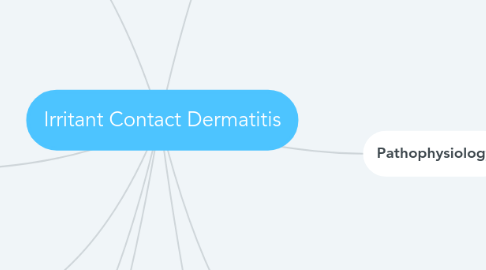
1. Risk Factors
1.1. Individuals who work with Chemicals
1.1.1. Nurses
1.1.2. Printers
1.1.2.1. Newspaper
1.1.2.2. Magazine
1.1.3. Farmers
1.1.4. Coal Miners
1.1.5. Salon Workers
1.1.5.1. Hair
1.1.5.2. Nails
1.1.6. Auto Mechanics
1.1.7. Cleaners
1.1.7.1. Residential
1.1.7.2. Commercial
1.1.7.3. Laundry
2. Clinical Presentations
2.1. Inflammation
2.1.1. Infection
2.1.1.1. Antibiotics
2.2. Redness
2.3. Swelling
2.4. Dryness, Flakiness of Skin
2.5. Pruritis
2.6. Thickened Skin
3. Diagnosis
3.1. History and physical
3.2. Assessment
3.2.1. No Formal Testing Necessary
4. Definition
4.1. Irritant contact dermatitis (ICD) is a nonspecific inflammatory response of the skin to various external stimuli.
5. Treatment
5.1. Removal of Irritant
5.2. Topical agent
5.3. Antibiotics only secondary to infection
6. Epidemiology
6.1. Distribution
6.1.1. Frequency
6.1.1.1. Prevalence Unknown
6.1.1.1.1. Frequently misdiagnosed
6.1.2. Pattern
6.1.2.1. Appears within minutes to hours
6.1.2.2. Can last 2-4 weeks
6.2. Determinants
6.2.1. Occupational or Work Hazard
6.2.1.1. Repeated Handwashing
6.2.1.1.1. Medical field
6.2.1.1.2. To prevent use moisturizer
6.2.1.2. Repeated exposure to chemicals
6.2.1.2.1. Lack of PPE
6.3. Factors that affect severity
6.3.1. Amount of irritant
6.3.2. Strength of irritant
6.3.3. Amount of time skin was exposed to irritant
7. Pathophysiology
7.1. Irritant contact with skin
7.1.1. Activated Innate Immune System
7.1.1.1. Pro-inflammatory Response
7.1.1.1.1. Inflammation
7.1.1.1.2. Redness
7.1.1.1.3. Swelling
7.1.1.2. Vasodilation
7.1.1.3. Increased vascular permeability
7.1.1.3.1. delivery of leukocytes, plasma proteins, and other biochemical mediators
7.1.1.4. Increased blood flow to site of injury
7.1.1.5. Activation of IL-1α
7.1.1.5.1. production of IL-1β
7.1.1.5.2. production of TNF-α
7.1.1.5.3. production of IL-6
7.1.1.5.4. production of IL-8
8. Adaptive Responses
8.1. Chronic form of Irritant Contact Dermatitis
8.1.1. dryness, fissuring, and hyperkeratosis
8.1.1.1. abnormal thickening of the outer layer of the skin.
8.2. Allergic Contact Dermatitis
8.2.1. Irritant contact with the skin
8.2.1.1. delayed hypersensitivity response
8.2.1.1.1. irritant binds to an endogenous carrier protein forming a sensitizing antigen
9. Causes
9.1. Friction
9.2. Cold
9.3. Heat
9.4. Over-exposure to water
9.5. Chemicals
9.5.1. Alkalis
9.5.2. Acids
9.5.3. Detergents
9.5.4. Solvents

